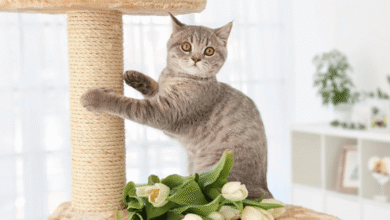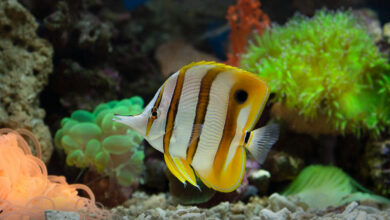Meet the Butterfly Telescope Goldfish: A Stunning Aquarium

Hold your breath as you are about to be captivated by the sheer dazzling beauty of the Butterfly Telescope Goldfish! This variant of goldfish has gained worldwide popularity for its peculiar looks and unique personality. The Butterfly Telescope Goldfish is indeed a stunning spectacle in any aquatic environment due to its distinctive appearance and captivating character.
A look into this amazing fish’s world will leave you spellbound as it gracefully moves and comes in vibrant colors, and its owners derive great happiness from it. Whether you are an experienced aquarist or just beginning this hobby, owning a Butterfly Telescope Goldfish should top your list.
Characteristics and Appearance of the Butterfly Telescope Goldfish
This is a fascinating variety of goldfish that is different from other most popularly known breeds. Its eyes are what make it stand out; they bulge out so much that anyone can see them clearly on either side of its head, taking on a unique telescope shape.
But there is more to why the Butterfly Telescope Goldfish is so appealing. The body boasts of beautiful shades such as bright orange or yellow to delicate black and white patterns. The fins also have a mesmerizing effect as they stretch out like butterfly wings, giving it a graceful overall look.
One more interesting thing about the physical appearance of the fish called Butterfly Telescope Goldfish is its body shape, which makes it look outstanding among others. It has a longer, slimmer form than ordinary rounded goldfish, suggesting elegant, sleek lines for one’s observation.
Setting up a Suitable Tank for Butterfly Telescope Goldfish
You must offer the right tank environment if your butterfly telescope goldfish will be healthy and grow well. In adulthood, these fish attain large sizes; therefore, they require tank space that can accommodate their adult length, which could reach up to 8 inches long.
- Tank Size: A single tank size should not be less than 30 gallons for one Butterfly Telescope Goldfish and 10 gallons for each additional fish.
- Substrate: They are comfortable on a soft, fine-grain substrate like sand or small gravel.
- Decorations: Incorporate plants, rocks, and driftwood in the tank to create an attractive place that enriches your butterfly telescope fish.
- Lighting: Maintain adequate lighting that gives the impression of daylight, as these fish prefer well-lit aquariums.
- Filtration: Invest in an effective filtration system that will help remove waste and allow your water to remain at optimum conditions.
This way, you will create enough space for your Butterfly Telescope goldfish to exhibit its amazing beauty as it thrives best in large environments, even though it can also do well in smaller ones if taken care of well.
Water Requirements and Filtration for Butterfly Telescope Goldfish
To keep your Butterfly Telescope goldfish healthy, maintaining appropriate water parameters is important. These sensitive fishes require specific balances of various parameters to keep them alive; therefore, they cannot survive anywhere else except where such delicate equilibrium exists.
Below are the recommended water requirements when keeping Butterfly Telescope Goldfish:
- Temperature – Keep the water temperature between 68°F and 75°F (20°C to 24°C).
- pH – The pH should be within a range of about 6.5-7.5.
- Ammonia & Nitrites Levels -0 ppm readings should always be maintained when dealing with ammonia and nitrites, which are toxic substances found in almost every aquarium.
- Nitrates Level – Below 20 ppm is the ideal level for nitrates.
- Hardness- A hardness range should be kept at between 5-15 dGH.
To have the best water quality, a dependable filtration system is necessary. It is advisable to buy a high-quality filter that can effectively eliminate waste products and dirt, prevent issues such as bacterial bloom, and maintain appropriate water conditions for your fish. You may want to consider combining mechanical, biological, and chemical methods of filtering.
You will be able to observe the ideal water condition for your Butterfly Telescope Goldfish by conducting routine water tests and changing part of it (approximately 25-30% weekly).
Feeding and Nutrition for Butterfly Telescope Goldfish
For your Butterfly Telescope Goldfish’s health and growth, you must provide them with a balanced and nutritious diet. These fish are omnivorous; hence, they require different types of food.
- Food Types: High-quality flakes, pellets, as well as freeze-dried or frozen foods (such as brine shrimp, bloodworms, or daphnia) should be used in combination.
- Feeding Frequency: Ensure that you feed the goldfish two to three times daily with an amount that can be finished within a few minutes.
- Portion Control: Avoid overfeeding since Butterfly Telescope Goldfish are typically vulnerable to obesity, which results in numerous disorders.
- Variety: Introduce all kinds of food so that your fish has a complete nutritional profile.
- Sinking Foods: Use sinking pellets or wafers so that food does not float but instead sinks in order to encourage their natural feeding habit.
Consistently feeding them at regular intervals while also varying their diets will ensure healthy butterfly telescope goldfish with bright colors exhibited throughout their bodies, including fins.
Common Health Issues and Care Tips for Butterfly Telescope Goldfish
Although generally hardy, the care of these pets becomes important because they often get sick when not properly looked after. This requires knowing what they might suffer from as well as undertaking preventive measures on time so that the problems do not become severe and thus affect your aquatic companions’ future.
- Swim Bladder Disorder: In this case, the fish faces buoyancy problems, which make it swim abnormally or even float on top of water. Good water quality, avoiding excessive feeding, and having a variety of food will help curb this problem.
- Fin and Skin Infections: Always maintain excellent water quality and do not stock too many fish in the tank since this can cause bacterial or fungal infections that affect skin and fin.
- Dropsy: This condition is life-threatening as a bloated appearance like a “pine cone.” It is necessary to address any contributing factors, such as poor nutrition or water quality, so as to reduce dropsy if you can.
- Parasitic Infestations: Observe your Butterfly Telescope Goldfish for parasite signs, including white spots or any abnormal behavior, then use the proper medication therapy accordingly.
- Obesity: However, butterfly goldfish, as mentioned earlier, tend to become fat, which may trigger certain health complications. For your fish to be in its best shape, ensure the consumption of a balanced diet without overfeeding them.
By practising due diligence, creating the correct atmosphere, and dealing with health concerns quickly, you will secure the long-term survival of your Butterfly Telescope Goldfish.
Compatible Tank Mates for Butterfly Telescope Goldfish
It is important to consider butterfly telescope goldfish’s peaceful nature and their special care when selecting the appropriate tank mates. They live comfortably with other peaceful species but select ones that will not nip their delicate fins nor outcompete them in the food supply.
Here are some suitable tank mate options for Butterfly Telescope Goldfish:
- Other Goldfish Varieties: Comet, Shubunkin, and fantail goldfish are examples of other breeds that can be excellent companions since they have similar water conditions requirements and temperaments.
- Peaceful Freshwater Fish: Danios, Rasboras, Corydoras Catfish, and Tetras can also make good tankmates, provided the tank size is big enough.
- Invertebrates: Snails like Amano Shrimp or Cherry Shrimp should not harm butterfly telescope goldfish, so their tank addition is possible.
It is important to know that Butterfly Telescope Goldfish are very docile creatures and may not do well in a goldfish tank where it has aggressive or boisterous tankmates. Avoid fish that bite fins or compete for food and space resources, such as this species.
Breeding and Reproduction of Butterfly Telescope Goldfish
Experienced aquarists will find breeding Butterfly Telescopes fascinating and fulfilling if properly done. However, careful preparation is required for the process, which involves some minor decisions.
Here’s a brief overview of the breeding process for Butterfly Telescope Goldfish:
- Sexing: It is difficult to determine whether a butterfly telescope goldfish is male or female as sexual dimorphism is not pronounced. Professional breeders are usually able to tell by body shape changes as well as fin sizes when determining sex in this genre.
- Conditioning: Prepare your pair by feeding them a nutritious, balanced diet while providing optimal water parameters in a separate breeder’s tank. This ensures they are in top condition before spawning takes place.
- Spawning: At the right conditions, the male Butterfly Telescopes exhibit courtship behavior, such as chasing females around and making her release eggs, which he then fertilizes.
- Egg Care: After laying its eggs, it becomes necessary to monitor and care for them so as to have a successful hatching process. Parents must be removed in some cases to avoid eating the eggs.
- Fry Care: For fry to grow and develop into healthy adult Butterfly Telescopes, they require a specialized diet and well-kept aquariums.
Breeding butterfly telescope goldfish is an arduous but rewarding process, and tips from experienced breeders or reliable sources are necessary for one’s success.
Conclusion
Butterfly Telescope Goldfish, a rare gem in the aquarium world, has been fascinating to aquarists with its breathtaking appearance and endearing disposition. Understanding its unique care requirements, as well as creating a suitable environment, would help you maximize the potential of this extraordinary fish so that you can enjoy its magical presence in your home aquarium.




